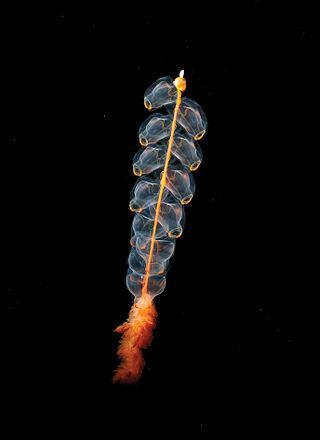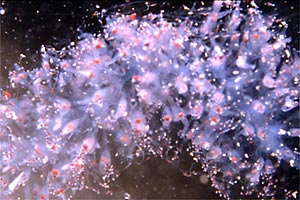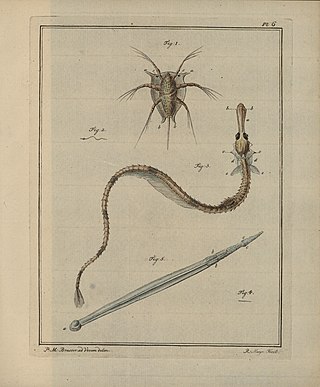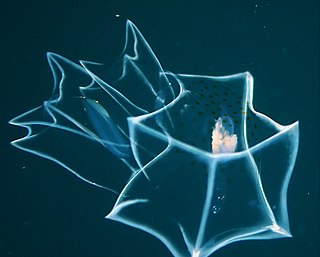
Zooplankton are the animal component of the planktonic community, having to consume other organisms to thrive. Plankton are aquatic organisms that are unable to swim effectively against currents. Consequently, they drift or are carried along by currents in the ocean, or by currents in seas, lakes or rivers.

The Portuguese man o' war, also known as the man-of-war, is a marine hydrozoan found in the Atlantic Ocean and the Indian Ocean. It is considered to be the same species as the Pacific man o' war or bluebottle, which is found mainly in the Pacific Ocean. The Portuguese man o' war is the only species in the genus Physalia, which in turn is the only genus in the family Physaliidae.

Lobata is an order of transparent marine invertebrates belonging to the phylum of Ctenophora in the class Tentaculata, and are commonly referred to as comb jellies or sea gooseberries. There are currently 19 extant known species in the order of Lobata. Members of Lobata exhibit a compressed body in the vertical plane and a pair of oral lobes. They are known to inhabit marine pelagic surfaces and the marine shores.

Siphonophorae is an order within Hydrozoa, which is a class of marine organisms within the phylum Cnidaria. According to the World Register of Marine Species, the order contains 175 species described thus far.

Holoplankton are organisms that are planktic for their entire life cycle. Holoplankton can be contrasted with meroplankton, which are planktic organisms that spend part of their life cycle in the benthic zone. Examples of holoplankton include some diatoms, radiolarians, some dinoflagellates, foraminifera, amphipods, krill, copepods, and salps, as well as some gastropod mollusk species. Holoplankton dwell in the pelagic zone as opposed to the benthic zone. Holoplankton include both phytoplankton and zooplankton and vary in size. The most common plankton are protists.

Pyrosomes, genus Pyrosoma, are free-floating colonial tunicates that usually live in the upper layers of the open ocean in warm seas, although some may be found at greater depths. Pyrosomes are cylindrical or cone-shaped colonies up to 18 m (60 ft) long, made up of hundreds to thousands of individuals, known as zooids. Colonies range in size from less than one centimeter to several metres in length. They are commonly called "sea pickles". Other nicknames include "sea worms", "sea squirts", "fire bodies", and "cockroaches of the sea".

Pelagic fish live in the pelagic zone of ocean or lake waters—being neither close to the bottom nor near the shore—in contrast with demersal fish that live on or near the bottom, and reef fish that are associated with coral reefs.

Diel vertical migration (DVM), also known as diurnal vertical migration, is a pattern of movement used by some organisms, such as copepods, living in the ocean and in lakes. The word "diel" comes from Latin: diēs, lit. 'day', and means a 24-hour period. The migration occurs when organisms move up to the uppermost layer of the sea at night and return to the bottom of the daylight zone of the oceans or to the dense, bottom layer of lakes during the day. It is important to the functioning of deep-sea food webs and the biologically driven sequestration of carbon.

Praya dubia, the giant siphonophore, lives in the deep sea at 700 m (2,300 ft) to 1,000 m (3,300 ft) below sea level. It has been found off the coasts around the world, from Iceland in the North Atlantic to Chile in the South Pacific.

Chrysaora hysoscella, the compass jellyfish, is a common species of jellyfish that inhabits coastal waters in temperate regions of the northeastern Atlantic Ocean, including the North Sea and Mediterranean Sea. In the past it was also recorded in the southeastern Atlantic, including South Africa, but this was caused by confusion with close relatives; C. africana, C. fulgida and an undescribed species tentatively referred to as "C. agulhensis".

Marrus orthocanna species of pelagic siphonophore, a colonial animal composed of a complex arrangement of zooids, some of which are polyps and some medusae. Swimming independently in the mid-ocean, it lives in the Arctic and other cold, deep waters. It is a colonial creature that is born from a single egg which is fertilized. Later on, a protozoan forms that eventually grows to form more duplicating members of the colony. It belongs to the order Siphonophorae and the genus Marrus, which also includes M. antarcticus, M. claudanielis, and M. orthocannoides.

Apolemia is a genus of siphonophores. It is the only genus in the monotypic family Apolemiidae.

Apolemia uvaria, commonly known as string jellyfish, barbed wire jellyfish, and long stringy stingy thingy, is a siphonophore in the family Apolemiidae.

Parasagitta setosa, the coastal arrow worm, is a small arrow worm in the family Sagittidae, previously referred to as Sagitta setosa. It is native to the northeastern Atlantic Ocean, the North Sea and the Mediterranean Sea, and also occurs in the Baltic Sea and the Black Sea.
Muggiaea kochii is a species of small hydrozoan, a siphonophore in the family Diphyidae.

Physonectae is a suborder of siphonophores. In Japanese it is called 胞泳.

Calycophorae is a suborder of Siphonophores alongside two other suborders Physonectae and Cystonectae. This suborder includes the giant siphonophore, ; one of the longest lengthwise extant creatures (40–50m). While the Physonectae have a pneumatophore, nectophore, and a siphosome, Cystonectae lack a nectophore, and Calycophorae lack a pneumatophore. From the bell-shaped nectophores, Physonectae and Calycophorae are called Codonophores or Greek for bell-bearers. The distribution, morphology, and behaviors of Calycophorae species are vast and greatly depend on the species. Calycophoraes typically consist of two nectophores with a siphosome that have many tentacles that grow out of the siphosome. The Calycophoraes move by propelling water out of the nectophore much like how jellyfishes move. The tentacles act as fishing nets where the nematocysts on the tentacles paralyze their prey which are then later fed on. Calycophorae have three life stages, which are the larval development stage, the polygastric stage, and the eudoxid maturation stage. Each Calycophorae colony forms from one fertilized egg.

Bassia is a monotypic siphonophore genus in the family Abylidae. The genus contains the single species Bassia bassensis.
Lensia is a genus of hydrozoans belonging to the order Siphonoporae and the family Diphyidae. This genus is colonial and consists of many different types of highly specialized zooids. The genus Lensia was first established in 1932 by Dr. Arthur Knyvett Totton, who would also describe and add another 11 species during his career. As of March 2023, the genus consists of only 26 described and accepted species and an additional seven uncertain species, according to the World Register of Marine Species.
Tima nigroannulata, commonly known as the elegant jellyfish, is a recently discovered colonial hydrozoa found on the Pacific coast of Japan.
2. Andersen V., J. Sardou (1992). The diel migrations and vertical distributions of zooplankton and micronekton in the Northwestcrn Mediterranean Sea. 1. Euphausiids, mysids, decapods and fishes. J. Plankton Res. 14, 1129-1554
Buecher, E., 1999. Appearance of Chelophyes appendiculata and Abylopsis tetragona (Cnidaria, Siphonophora) in the Bay of Villefranche, northwestern. Mediterranean. Journal of Sea Research 41, 295–307
Castelbon C. (1987). Les migrations nycthémérales du zooplancton. Déterminisme expérimental des réactions locomotrices. Thèse de Doctorat ès Sciences, Université Aix-Marseille II, 380 p.
Guerrero, E., Kienberger, K., Villaescusa, A. et al. First record of beaching events for a calycophoran siphonophore: Abylopsis tetragona (Otto, 1823) at the Strait of Gibraltar. Mar Biodiv 49, 1587–1593 (2019). https://doi.org/10.1007/s12526-018-0926-1
GREVE,W., 1977. Interspecific interaction: the analysis of complex structures in carnivorous zooplankton populations. Helgol. Wiss. Meeresunters., Vol. 30, pp. 83–91

















